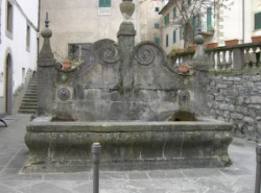Fontana di Piazza a San Marcello

In the centre of the town of San Marcello Pistoiese is this elegant fountain of rather monumental proportions. It stands in Piazzetta Port’Arsa, a few metres ahead on the left of the arch that once framed the ancient “Arsa” gate, which leads onto Via Roma. The public fountain, entirely in pietra serena, has a large rectangular basin, moulded on the corners and on the upper edge, set against a high headboard. The headboard, in squared stone blocks arranged in rows, is rather rich: at the ends two small pillars support truncated pyramids surmounted by balls with pointed cusps; from the pillars two large volutes in relief on the stone start, and in the centre another small pillar rises, this one surmounted by an elegant stone vase. The water flows from two lateral spouts, applied halfway up the headboard. It is difficult to give a precise chronology, but we certainly must not be fooled by the date “1893” engraved on the back of the headboard; the date in question refers in fact to a move undergone by the fountain. The fountain is in any case very old and its history quite complex: the one in 1893 is not the only move that has affected it. The fountain of Port'Arsa must date back at least to the 16th century; in fact among the first testimonies that recall its existence is that of Domenico Cini, who in recalling the arrival of the Grand Duke Francesco de' Medici and his wife Bianca Cappello in San Marcello in 1579, explains that the two princes lived in the then Calestrini house, which in the Middle Ages was the residence of the Podestà (which remains, let us remember, adjacent to the current Via Guidi), and that the courtyard adjacent to this house "was under the public fountain in the square". The fountain stood in other words at the end of the current Piazza Matteotti, roughly between the ancient Palazzo della Cancelleria and the Pretorio Palace located almost opposite, leaning against a high wall that delimited the square itself; beyond the wall was the courtyard of the house that passed from the Calestrini to the Pelliccia family and was then purchased, in 1624, by Lorenzo di Tommaso Cini, and next to this was a small piece of vegetable garden; the fountain stood on a stone pavement. Over the centuries, the fountain has changed location three times. The first move dates back to 1771: the construction of the Ximeniana road was underway and in that year the section up to San Marcello was completed. At that time, various interventions were taking place in the town, including the restoration of various public buildings and the construction of the inn and the post office; the fountain was also restored and subsequently moved. It was placed in another space in the square, near the previous one, but it did not last long in this new location. In 1779, the technician in charge of the checks on the Grand Ducal road, Giovanni Gamberai, asked for it to be removed, proposing that it be moved to the portion of land more or less in front of the Palazzo Pretorio, advising that it be rebuilt with the same stones and materials. So it was done and, on the edge of the Ximenes road, it remained for almost the entire 19th century. At the end of the century, in fact, due to the inconvenience caused by the narrow “via per Gavinana” (remember that the grand-ducal road passed through the current via Roma), it was decided to build an overpass that crossed the Susina ditch, connecting the Ximenes – Giardini and thus avoiding the passage from Port’Arsa. But the fountain was placed at the abutment of the planned overpass, so in 1893 the Mayor informed the city council of the need to move it elsewhere, proposing the place where it is now located. The date engraved on the back of the fountain commemorates this last move. During the numerous moves the structure certainly underwent some changes: for example, we know of an intervention in 1881 to repair the water pipes, where it was planned to build "a new drinking trough behind the fountain in the square of the same size as the existing one", and the presence of the drinking trough is attested as early as 1825. Locality San Marcello

 Italiano
Italiano